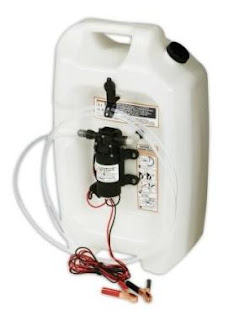 I visited the boat yesterday, intending mainly just to check on it after a full unattended month. I had hoped the shrink wrap would be finished (with a zippered access door), so I could climb aboard and make sure there were no moisture problems inside. Shrink wrap sometimes results in condensation, which can lead to mildew and other problems.
I visited the boat yesterday, intending mainly just to check on it after a full unattended month. I had hoped the shrink wrap would be finished (with a zippered access door), so I could climb aboard and make sure there were no moisture problems inside. Shrink wrap sometimes results in condensation, which can lead to mildew and other problems.The shrink wrap is done, and appears well-ventilated, but they didn't include an access door. I'm not sure if I forgot to request one, or if they missed it on the work order. No big deal, I'll add one myself. It will be cheaper that way anyway: I just ordered one from Dr. Shrink for $14.00.
I had also hoped to do a quick assessment of what I will need in order to complete some winter projects, but I guess I will have to wait until the zipper door arrives. As always, I have a list of projects a mile long. Some are important and will be done before spring launch. Some are just "nice-to-have" and can wait indefinitely if need be. On my project list, roughly in priority order:
- Wiper motors. This is at the top of the list because, after last season, I consider it an important safety item. On several occasions (mainly head seas), visibility from the lower helm was seriously impaired by the broken port wiper. The starboard wiper, while functional, wasn't completely reliable either.
- Electronics wiring. The GPS and VHF radio connections are not complete, which means our DSC capability is limited. Plus, although our GPS runs fine on it's rechargeable batteries, a constant connection to the on board batteries will be helpful in keeping it charged.
- Impeller. I have no idea when the raw water impeller was last done. We've had the boat two seasons, so it's probably past due.
- Exterior teak. The swim platform desperately needs refinishing. I think it will require complete sanding and three or four coats of Cetol Light. The remaining teak (the cabin door, flybridge steps, and flybridge seat) are in good shape, and just need a maintenance coat or two.
- Bottom paint. As you can see in the picture below, the old paint is in decent condition, but it has worn worn off in some areas. A new coat or two in the spring should keep the bottom in good shape over the next season.
- Starting battery. I initially purchased a single group 27 deep-cycle battery for the house, and group 27 dual-purpose for a starting battery. I've since concluded that this configuration is woefully inadequate. I plan to combine the two existing batteries for the house needs, and add a single group 31 for a new starting battery.
- Battery charger outlet. Our battery charger currently plugs in to an outlet outside the port bench, and the cord gets in the way. I want to add an outlet inside the bench.
- Backup bilge pump. One could argue that this should be higher on the list. We have a single bilge pump. If it ever fails, or if we have a catastrophic leak, we'll need a high-capacity backup.
- Rebed windshield. Our center windshield leaks, so it needs to be removed and rebedded. Might be a major project, so I'm not sure it will get done this year.
- Anchor roller. My back would thank me, but again, I'm not sure this will get done this year.
- Chafe guards. Some of our lines are chafing where they run through chocks or around cleats.
- Replace life jackets. Some of our life jackets still say "Cuanna", the boat's prior name.
- Dri-dek for anchor locker. I want put down dri-dek panels in the anchor locker to protect the surface from the anchor, chain, etc.
- Galley water filter. A water filter might improve the taste enough that we can skip the gallon jugs of drinking water.
- Toilet paper holder. Inside the vanity in the head, where it won't get wet from showers.
- Drink holders. For the flybridge.
- FM antenna. Mostly we listen to our iRiver Clix anyway, but we have a nice new stereo, so it seems like it should have an antenna!



































